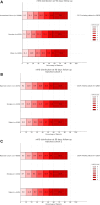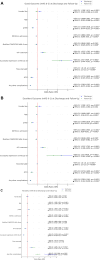Sex-Related Differences in Outcomes of Endovascular Treatment in Large Vessel Occlusion Stroke-Analyses From the German Stroke Registry-Endovascular Treatment
- PMID: 40008680
- PMCID: PMC11863069
- DOI: 10.1111/ene.70092
Sex-Related Differences in Outcomes of Endovascular Treatment in Large Vessel Occlusion Stroke-Analyses From the German Stroke Registry-Endovascular Treatment
Abstract
Background: Sex-related differences in acute ischemic stroke may affect outcomes, yet evidence remains inconsistent. This large-scale study investigated sex-related differences in clinical presentation, peri-interventional parameters, and outcomes after endovascular thrombectomy (EVT) for large vessel occlusion (LVO) using data from the German Stroke Registry-Endovascular Treatment (GSR-ET).
Methods: We analyzed 11.896 EVT patients (52.2% female) from the GSR-ET (June 2015-December 2021) comparing clinical characteristics, treatment details, and outcomes by sex. Two propensity score matchings (PSM) were applied: (1) logistic regression model with a caliper width of 0.1 on age, pre-stroke modified Rankin Scale (pmRS), and National Institutes of Health Stroke Scale at admission, and (2) 1:1 nearest neighbor matching with a caliper of 0.01. Primary outcomes were good (mRS 0-2) and excellent (mRS 0-1) outcomes at discharge and 90-day follow-up.
Results: Women were older (76.3 ± 12.7 vs. 70.2 ± 12.9 years, p < 0.001) and had higher pre-stroke disability (median pmRS 0 (0, 2) vs. 0 (0, 1), p < 0.001). Cardioembolic strokes were more frequent in women, even after PSM. Despite this, women had better odds of achieving good outcomes at discharge (adjusted OR 1.20, 95% CI 1.04-1.38, p = 0.013), but not at follow-up (OR 0.91, 95% CI 0.78-1.05, p = 0.193). Both PSM analyses confirmed these findings.
Conclusions: While women demonstrated better short-term functional outcomes after EVT, these benefits diminished in follow-up. The persistence of cardioembolic stroke in women suggests potential sex-specific mechanisms. Understanding and addressing sex-related differences in stroke is essential to optimize acute stroke care and improve outcomes. Future studies should explore biological and socio-economic factors influencing sex-related differences.
Trial registration: ClinicalTrials.gov identifier: NCT03356392.
Keywords: acute management; endovascular thrombectomy; female; intensive care; intravenous thrombolysis; sex‐related differences; stroke.
© 2025 The Author(s). European Journal of Neurology published by John Wiley & Sons Ltd on behalf of European Academy of Neurology.
Conflict of interest statement
Constanze Single, Kornelia Laichinger, Jennifer Sartor‐Pfeiffer, Nadja Selo, Florian Hennersdorf, Benjamin Bender, Joshua Mbroh, and Ulrike Ernemann are reporting no disclosures. Annerose Mengel received grants from the University of Tübingen (AKF) and speakers' honoraria/consulting fees from AMGEN, all not related to this work. Milani Deb‐Chatterji received research grants from the Werner Otto Stiftung and University Hospital Schleswig‐Holstein and speaker honoraria from Astra Zeneca (not related to this work). Götz Thomalla reports honoraria as consultant or lecturer from Acandis, Alexion, Amarin, Bayer, Boehringer Ingelheim, BristolMyersSquibb/Pfizer, Stryker, and research grants from the European Union (Horizon 2020), German Research Foundation (DFG), and the German Innovation Fund. Sven Poli reports research support from BMS/Pfizer, Boehringer Ingelheim, Daiichi Sankyo, German Federal Joint Committee Innovation Fund, and German Federal Ministry of Education and Research, Helena Laboratories and Werfen as well as speakers' honoraria/consulting fees from Alexion, AstraZeneca, Bayer, Boehringer Ingelheim, Bristol Myers Squibb/Pfizer, Daiichi Sankyo, Portola, and Werfen (not related to this work). Ulf Ziemann received grants from the European Research Council (ERC), German Ministry of Education and Research (BMBF), German Research Foundation (DFG), Else‐Kröner Fresenius Foundation, and consulting fees from CorTec GmbH (not related to this work). Katharina Feil received grants from the University of Tübingen (AKF) and speakers' honoraria/consulting fees from AstraZeneca and BMS/Pfizer (not related to this work).
Figures




References
-
- Gall S. L., Donnan G., Dewey H. M., et al., “Sex Differences in Presentation, Severity, and Management of Stroke in a Population‐Based Study,” Neurology 74, no. 12 (2010): 975–981. - PubMed
-
- Grimes K., Mehndiratta P., and Chaturvedi S., “The Impact of Sex on Stroke Care: From Epidemiology to Outcome,” Journal of Stroke and Cerebrovascular Diseases 33 (2024): 107675. - PubMed
Publication types
MeSH terms
Associated data
LinkOut - more resources
Full Text Sources
Medical
Miscellaneous

